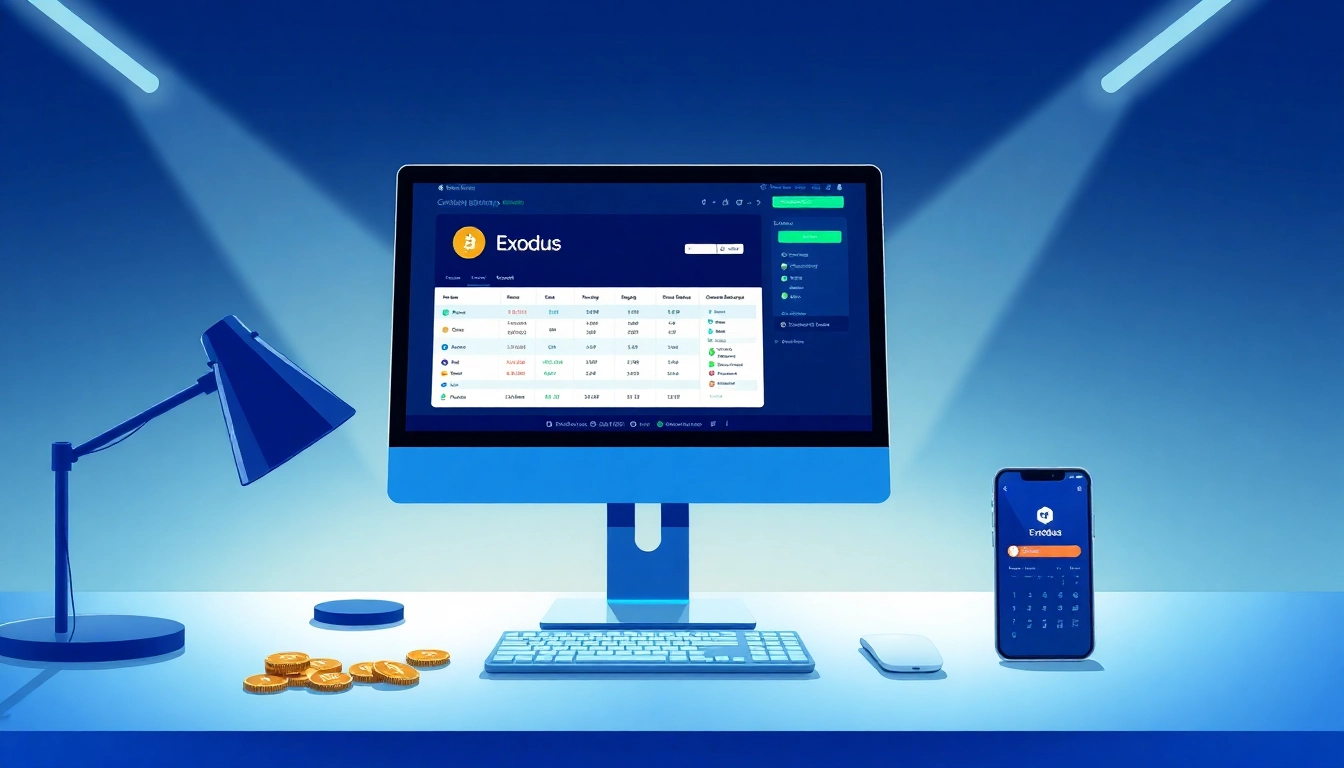What is the Exodus Wallet?
The exodus wallet is a leading non-custodial cryptocurrency wallet that empowers users to manage, store, and trade digital assets in a secure and user-friendly manner. With a sleek design and an intuitive interface, Exodus has positioned itself as a go-to platform for both novices and experienced crypto users. It supports a wide variety of cryptocurrencies and has built-in exchange features, providing a comprehensive solution for anyone looking to navigate the crypto space.
Overview of Features and Benefits
Exodus Wallet offers a plethora of features that enhance the user experience while providing robust security. Key features include:
- Multi-Currency Support: Exodus supports over 130 types of cryptocurrencies, including Bitcoin, Ethereum, Litecoin, and many altcoins, allowing users to diversify their portfolios easily.
- User-Friendly Design: The wallet’s interface is designed for ease of use, with a simple and intuitive layout that even beginners can navigate.
- Built-In Exchange: Users can swap one cryptocurrency for another directly within the wallet without having to go through external exchanges, which streamlines the trading process.
- Offline Access: Exodus allows users to keep their wallets offline when not in use, enhancing security and reducing vulnerability to hacking attempts.
- Cross-Platform Availability: Available on both desktop and mobile devices, Exodus ensures users have access to their assets wherever they are.
Supported Cryptocurrencies and Assets
As a versatile wallet, Exodus caters to users interested in a wide range of digital currencies. Besides Bitcoin and Ethereum, the wallet supports major tokens like Bitcoin Cash, Dash, Zcash, and numerous ERC-20 tokens. This extensive support allows users to manage and trade various digital assets all in one place, appealing to those who may want to explore lesser-known currencies.
How Exodus Wallet Compares to Competitors
When compared to other wallets such as Coinbase Wallet or Trust Wallet, Exodus stands out due to its non-custodial nature and beautiful design. Unlike custodial wallets that require users to trust third parties with their assets, Exodus ensures that users have complete control over their private keys. Furthermore, its built-in exchange feature simplifies swapping assets, which is something that many competitor wallets do not provide.
In terms of usability, Exodus excels with its straightforward onboarding process and overall user experience, making it suitable for those new to cryptocurrency management, while still being robust enough for experienced traders looking for a comprehensive wallet solution.
Getting Started with Exodus Wallet
Installation: Step-by-Step Guide
Getting started with the Exodus Wallet is a straightforward process:
- Download the Wallet: Visit the official Exodus website or your device’s application store to download the wallet for desktop or mobile.
- Install the Application: Follow the prompts to install the application on your device. The installation process is seamless and does not require much technical knowledge.
- Create Your Wallet: Upon first launching the app, you will be prompted to create a new wallet. Make sure to create a strong password to protect your wallet.
- Backup Your Wallet: Exodus will guide you through the process of backing up your wallet, which is crucial. You will be given a recovery phrase that you should write down and store in a safe place.
- Explore the Interface: Familiarize yourself with the features of the wallet, such as the dashboard, exchange tools, and settings.
Setting Up Your Wallet and Security Options
Once installed, configuring security features is essential:
- Set Up Two-Factor Authentication: Though Exodus does not require registration, enabling additional security measures is wise for peace of mind.
- Monitor Your Transactions: Review transaction history and notifications to stay informed about your wallet’s activity and potential security issues.
- Use a Strong Password: Always use a unique and robust password for accessing your wallet. Additionally, never share your password or recovery phrase with anyone.
Making Your First Cryptocurrency Transaction
To make your first transaction, follow these steps:
- Deposit Funds: You can deposit crypto into your Exodus wallet by selecting the currency you wish to receive and copying the wallet address provided.
- Select a Currency to Trade: Navigate to the exchange tab, select the currency you currently hold and the one you want to swap it for.
- Input Amount: Enter the amount you want to exchange and review the transaction details, including fees and exchange rates.
- Confirm the Transaction: Once satisfied, confirm the trade and wait for the transaction to be processed. Your new assets will appear in your wallet shortly.
Understanding Exodus Wallet Security
Hot vs. Cold Storage: What You Need to Know
Understanding the difference between hot and cold storage is crucial for the security of your cryptocurrency. Hot wallets, like Exodus, are connected to the internet, making them convenient for trading and everyday tasks. However, this connection makes them more susceptible to hacking attempts.
Cold storage, on the other hand, involves keeping assets offline, which provides an extra layer of security against online threats. While Exodus does not offer traditional cold storage features built into the app, users can transfer their assets to a hardware wallet for enhanced security when not in use.
Best Practices for Keeping Your Assets Safe
To ensure the safety of your cryptocurrencies in Exodus, consider the following best practices:
- Regular Backups: Always back up your wallet and recovery phrase. Keep the backup secure and accessible only to you.
- Stay Updated: Keep your Exodus wallet updated to the latest version to benefit from security patches and new features.
- Use Strong Passwords: Avoid easily guessable passwords. Use a mix of letters, numbers, and symbols.
- Be Wary of Phishing: Always double-check URLs and be cautious of unsolicited messages asking for your wallet details.
Common Security Concerns Addressed
One of the most frequent concerns among users is the potential for hacking. Exodus has been proactive in addressing security vulnerabilities through regular software updates and by encouraging best security practices. Additionally, the company provides users with information about the risks associated with their wallets and how to mitigate them.
Another area of concern is the transparency of fees related to transactions. Although Exodus does not charge a fixed fee, it applies a spread on trades, which can vary. Understanding these costs can help users make informed decisions when exchanging cryptocurrencies within the wallet.
Advanced Features of the Exodus Wallet
Integrating with DeFi Protocols
Exodus Wallet not only supports traditional cryptocurrency functions but also integrates with decentralized finance (DeFi) protocols. This enables users to engage with liquidity pools, lending platforms, and yield farms directly from their wallet.
By utilizing DeFi, users can earn returns on their holdings by participating in staking or lending, thus generating passive income. The integration enhances the functionality of Exodus, making it more than just a storage tool but a comprehensive finance solution.
Using the Exchange Functionality Effectively
The built-in exchange feature enables users to perform trades without leaving the wallet. It is crucial to understand how this feature works to maximize its benefits:
- Compare Rates: Before exchanging, compare rates with external exchanges to ensure you are getting the best deal.
- Check Fees: Be mindful of the fees associated with trading within the wallet to avoid unexpected costs.
- Use Limit Orders: Although not available in all wallet functionalities, setting limit orders can help mitigate risks during volatile market conditions.
Leveraging Exodus Wallet for Passive Income
Exodus provides various methods to leverage your digital assets to generate passive income. Users can stake selected cryptocurrencies directly within the wallet to earn rewards over time. This feature is particularly appealing for users looking to grow their investment without actively trading.
Additionally, utilizing third-party DeFi protocols linked to Exodus can further increase potential earnings. However, users must do their research and understand the risks associated with DeFi investments, including platform reliability and market volatility.
Exodus Wallet: Reviews and User Experiences
What Users Are Saying About Exodus Wallet
User reviews of Exodus generally reflect a positive experience, with many highlighting its user-friendly interface and diverse asset support as significant advantages. Users also appreciate the built-in exchange feature, which simplifies trading.
However, some users have expressed concerns regarding fees, particularly for crypto swaps, which can sometimes be higher than those on dedicated exchanges. User feedback often focuses on improving transaction transparency and providing more detailed information about fees upfront.
Expert Reviews and Insights
Experts in cryptocurrency security and management have praised Exodus for its accessibility and ease of use. Many experts believe the wallet is particularly well-suited for beginners due to its straightforward design and comprehensive support documentation.
That said, experts recommend that users ensure they understand the security implications of holding assets in a hot wallet, emphasizing the importance of backups and personal security measures.
Handling Feedback and Suggestions for Improvement
Exodus actively encourages user feedback and frequently updates its software in response. Users have suggested improvements to transaction transparency and the addition of features like hardware wallet integration to enhance security further.
By prioritizing user experience, Exodus continues to refine its offerings, positioning itself competitively within the growing market for cryptocurrency wallets.







Leave a Reply